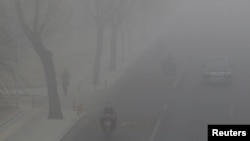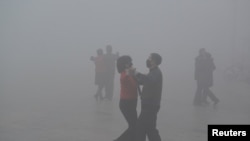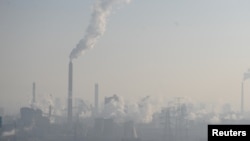In its “war” on hazardous air pollution, China’s government has a dilemma: It needs to be open about air quality data to hold polluters to account, but worries that too much bad news from alternative, independent sources could stoke public unrest.
Beijing has greatly improved how it collects data, made more of it available to the public and cracked down on misreporting, but it’s concerned about the spread of unauthorized or inaccurate data from popular mobile apps and handheld detectors.
The conflicting approach reflects a broader debate about China’s appetite for political reform. The Ministry of Environmental Protection (MEP), under a former academic, wants to create a modern regulatory system based on independent monitoring and the rule of law, but that could rub up against the ruling Communist Party’s priority for stability.
Measure smog, don't discuss it
After scandals about fraudulent data, the government also worries that alternative sources of information on pollution levels could erode public trust in official statistics, and undermine its message that the environment is improving.
Liam Bates, CEO of Origins Technology, which produces the Laser Egg handheld pollution monitor sold in Beijing’s Apple store, said China has no problem with people measuring air quality; it just doesn’t want the findings to be published.
“Basically [China] says it’s illegal to publish data from nonofficial sources. As far as I know there’s nothing about collecting data, or processing data and using it for research,” he said.
China says its main concern is accuracy.
In 2014, it ordered mobile phone pollution apps to drop data provided by the United States embassy and its consulates, concerned it might differ from its own. More recently, apps came under scrutiny for trying to give a more detailed picture than the government of China’s air quality.
In one recent example of what the government calls “rumor mongering” by individuals, a man was detained by police for five days in Chengdu in the southwest after he warned on his Weibo microblog that the city faced its “heaviest smog in its 2,000-year history,” local media reported.
Regulators also accused one air pollution-monitoring app of spreading rumors by providing data in December indicating Chengdu was the third most polluted city in the world.
While China’s short-staffed environmental watchdogs are keen to involve the public in enforcing standards, authorities are wary that social media-driven protests against chemical plants, waste incinerators or nuclear processing facilities could trigger protests.
“In general, there is hope at the provincial and ministerial level that they will not try to shut down all these other sources, but what they’re really concerned about is that they will show something that isn’t scientific,” said Ma Jun, director of the Institute for Public and Environmental Affairs (IPE), a nongovernment organization campaigning for greater transparency.
“This is a challenge in this era of mobile internet and social media,” he noted. The MEP did not respond to a faxed request for comment.
Information gaps
Despite progress on official information disclosure, led by the environment ministry, Ma says, there are still gaps, with agencies like the National Development and Reform Commission lagging and some local governments “reluctant and resistant.”
China still does not give out data for climate-warming carbon dioxide emissions, and offers only incomplete heavy metal pollution figures, a sensitive issue following food scandals in rice-growing regions. There is also reluctance to allow the free publication of sensitive data on the health impact of pollution.
There is no database on the health impact from pollution that companies could access to help them decide where to locate their staff.
While Chinese media have cited foreign studies on the correlation between smog and mortality, including the heavy death toll in London in the winter of 1952-53, there have been few equivalent Chinese studies.
As winter pollution gripped much of northern China last month, the health ministry told state media it had no data linking smog to cancer, and it was too early to reach any conclusions about the impact of PM2.5, the tiny particles that form smog, on human health, though foreign researchers say the evidence was available.
“The centers for disease control have this kind of data,” said Dan Greenbaum of the Health Effects Institute, which has studied the links between pollution and health.
Some foreign studies suggest pollution could cause more than 1 million premature deaths a year in China.
Public distrust
Despite doing more than many countries to make real-time air quality data publicly available, China has yet to overcome public skepticism about official statistics.
Recent cases of fraud have not helped. Last year, staff members at a monitoring station in the northwestern city of Xi’an were accused of tampering with equipment to reduce emissions measurements.
Beijing promises “zero tolerance” on statistical fraud and has brought as many as 1,436 local monitoring stations under central government control. It also uses satellite imagery to check local governments’ data accuracy.
But individuals are prepared to enter a legal gray area by measuring emissions themselves. One mobile phone app, AirMatters, with more than 9 million subscribers, got into trouble from at least one local government for crunching official data in alternative ways.
But the government itself is starting to use data from private citizens.
The IPE has its own app that allows users to report pollution on the ground, and the environment ministry feeds that information into its own official reporting platform.
Monitoring water pollution presents even tougher challenges, says Ma at the IPE, noting the high cost of measuring equipment.
“They [regulators] want the data to be the right data when it gets published. The next challenge will be [to see] who will be qualified to provide third-party monitoring services,” he said. “My gut feeling is that it will be no longer totally closed, but they want a more controlled opening of this space.”












